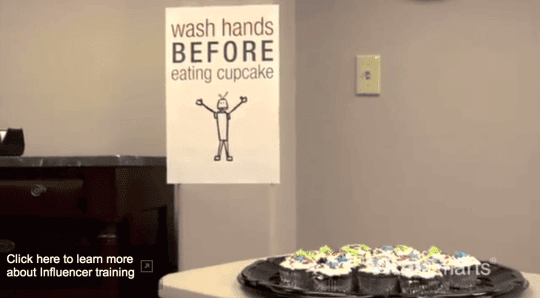A friend shared this fun video about how to influence hand washing behavior amongst a group of 12 kids. As the introduction points out, improper hand hygiene can be deadly in hospital settings.
In the scenario, the kids are given a task to complete, with the promise of cupcakes at the end as a reward:
In the first round, the facilitator explains that a kid who had done the exercise earlier was sick with a runny nose, so there's hand sanitizer in the room for you. This was creating a personal motivation — not wanting to get sick.
Not surprising, not a single kid walked across the room to use the hand gel.
For the second try, they told the kids about the risk of sickness, but they also moved the gel to be more convenient (a form of the 5S methodology, arguably) and hung a sign reminding the kids (regular reads will know my opinion on signs being ineffective). ZERO kids used the gel, even though it was right there.

They then added training and the change to practice – this led to two kids out of 12 washing their hands.
Then, they added “social influence,” where a peer somebody speaks up and says something at a key moment — 11 out of 12 kids washed their hands with the santizer!
The key point and the lesson? You have to combine different methods of influence (using four or more of the “six sources of influence” significantly increases your odds of success) – as described in the book Influencer: The Power to Change Anything – has anybody read it?
How can you apply these ideas to the things that are supposed to happen in hospitals, including:
- Hand hygiene in and out of patient rooms
- Pre-operative “time outs”
- Following other sorts of checklists?
Leave a comment below…
Please scroll down (or click) to post a comment. Connect with me on LinkedIn.
Let’s work together to build a culture of continuous improvement and psychological safety. If you're a leader looking to create lasting change—not just projects—I help organizations:
- Engage people at all levels in sustainable improvement
- Shift from fear of mistakes to learning from them
- Apply Lean thinking in practical, people-centered ways
Interested in coaching or a keynote talk? Let’s start a conversation.










We’ve shown this to some staff at our hospital. An interesting observation: when staff watch the different scenarios, many of them having children, they are usually able to predict how effective each strategy will be. For example, few staff are surprised that the education or awareness of the risk of being sick will be ineffective in dissuading the kids from flocking to the cupcakes without washing their hands.
My question: if we are able to predict and see that signage and awareness campaigns alone are ineffective in this scenario, how come we are often unable to see it in a clinical workplace setting?
Thanks for sharing the story. I would guess adults think we are more rational than children in that we’ll respond to the logical argument that we should want to avoid getting sick and prevent others from getting sick because it’s the right thing to do?
hi – I am an hr manager in a hospital in south Africa that deals with immune compromised patients and infection control is critical for us. I loved this simple video and with your permission will be running a case study along the same format with our 50 nurses. please forward me any other infection control related videos like this.
Much obliged.
Darren
Great article and video Mark. We’ve featured a number of articles on hand hygiene behavior recently and we’d love to share on our blog. Our readers are infection control and food safety professionals….we can all learn something from these kids!
[…] Influencing hand hygiene behaviourHow to influence the wasing behaviour among kids In a small experiment kids are given a task to complete, with the promise of cupcakes at the end as a reward: they have to clean their hands. See the video on the Lean blog. […]